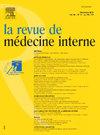L’hyperparathyroïdie primaire : du diagnostic à la prise en charge thérapeutique
IF 0.7
4区 医学
Q3 MEDICINE, GENERAL & INTERNAL
引用次数: 0
Abstract
Primary hyperparathyroidism (PHPT) is the leading cause of hypercalcemia. It is secondary to hypersecretion of parathyroid hormone (PTH) by the parathyroid glands. Today, PHTP is asymptomatic in 80–90% of cases. Its repercussions are mainly renal (nephrolithiasis, nephrocalcinosis, decline in renal function) and skeletal (osteoporosis, fractures), and should be systematically investigated. Diagnosis is only biological, and in its classic form relies on the association of hypercalcemia, inappropriate PTH (normal or elevated) and hypercalciuria. Diagnosis of normocalcemic forms, where only PTH is elevated, requires elimination of secondary hyperparathyroidism and confirmation of elevated PTH on two consecutive samples, over a 3 to 6 months period. Imaging evaluation, which combines neck ultrasound with scintigraphy or 18F-choline PET/CT, is of interest only if surgery is indicated. Surgical management of the hyperfunctioning parathyroid gland(s) is the only curative treatment for HPTP. Medical management concerns patients for whom surgery is not indicated, who present a surgical contraindication or who refuse surgery. The diagnosis of HPTP warrants contact with an endocrinologist to ensure its management.
[原发性甲状旁腺功能亢进症:从诊断到治疗]。
原发性甲状旁腺功能亢进症(PHPT)是导致高钙血症的主要原因。它继发于甲状旁腺分泌过多的甲状旁腺激素(PTH)。目前,80%-90%的 PHTP 病例没有症状。其影响主要是肾脏(肾结石、肾钙化、肾功能衰退)和骨骼(骨质疏松症、骨折),应进行系统的检查。诊断只是生物学上的,典型的诊断依赖于高钙血症、不适当的 PTH(正常或升高)和高钙尿。正常钙血症的诊断,即只有PTH升高,需要排除继发性甲状旁腺功能亢进,并在3至6个月内连续两次采样确认PTH升高。只有在有手术指征的情况下,才需要结合颈部超声和闪烁照相术或18F-胆碱PET/CT进行影像学评估。对功能亢进的甲状旁腺进行手术治疗是治愈 HPTP 的唯一方法。药物治疗适用于没有手术指征、有手术禁忌症或拒绝手术的患者。确诊为HPTP后,应与内分泌科医生联系,以确保治疗效果。
本文章由计算机程序翻译,如有差异,请以英文原文为准。
求助全文
约1分钟内获得全文
求助全文
来源期刊

Revue De Medecine Interne
医学-医学:内科
CiteScore
0.70
自引率
11.10%
发文量
526
审稿时长
37 days
期刊介绍:
Official journal of the SNFMI, La revue de medecine interne is indexed in the most prestigious databases. It is the most efficient French language journal available for internal medicine specialists who want to expand their knowledge and skills beyond their own discipline. It is also the main French language international medium for French research works. The journal publishes each month editorials, original articles, review articles, short communications, etc. These articles address the fundamental and innumerable facets of internal medicine, spanning all medical specialties. Manuscripts may be submitted in French or in English.
La revue de medecine interne also includes additional issues publishing the proceedings of the two annual French meetings of internal medicine (June and December), as well as thematic issues.
 求助内容:
求助内容: 应助结果提醒方式:
应助结果提醒方式:


